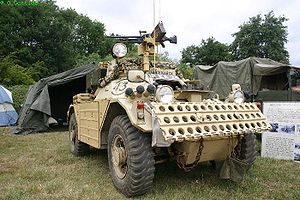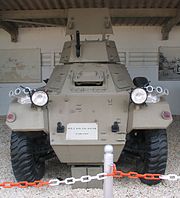| Ferret Scout Car | |
|---|---|
 Ferret Mk.1/2 in desert finish | |
| Type | Wheeled armoured fighting vehicle |
| Place of origin | United Kingdom |
| Specifications | |
| Mass | 3.7 t |
| Length | 12 ft 2 in (3.7 m) |
| Width | 6 ft 3 in (1.91 m) |
| Height | 6 ft 2 in (1.88 m) |
| Crew | 2 (commander, driver) |
|
| |
Main armament |
7.62mm GPMG if fitted .30 M1919 Browning machine gun |
Secondary armament | none |
| Engine |
Rolls Royce B60 Inlet over Exhaust I6 petrol 130 hp (97 kW) |
| Power/weight | 35.1 hp/tonne |
| Suspension | 4x4 wheel |
Operational range | 190 mi (310 km) |
| Maximum speed | 58 mph (93 km/h) |
The Ferret armoured car, also commonly called the Ferret Scout car, is a British armoured fighting vehicle designed and built for reconnaissance purposes. The Ferret was produced between 1952 and 1971 by the UK company, Daimler. It was widely adopted by regiments in the British Army as well as Commonwealth countries throughout the period.
History[]
The Ferret was developed in 1949 as a result of the British Army's need to obtain a replacement model for its Second World War light armoured vehicles. Due to the success of their Reconnaissance Scout Car, the "Dingo", Daimler was employed to design and manufacture the Ferret.
The Ferret shared many similar design features with the Dingo and Canadian Ford Lynx, but featured a larger fighting compartment and an optional small machine gun turret. It was built from an all-welded monocoque steel body, making the vehicle lower but also making the drive extremely noisy inside as all the running gear was within the enclosed body with the crew. Four wheel drive was incorporated together with "Run flat" tyres (which kept their shape even if punctured in battle, thus enabling a vehicle to drive to safety.) The turret, though not fitted to all models, carried a single machine gun. Six grenade launchers fitted to the hull (three on each side) could carry smoke grenades.
It is fast and small enough to be used in an urban environment but strong enough to negotiate rugged terrain off road. The Ferret is no longer in service in the British Army, although several Commonwealth countries still operate them to this day. They have been popular with private collectors due to the compact size and affordable price e.g. around $20,000 to $30,000 in the USA, $40,000 to $60,000 in Australia and New Zealand.
In 1975, 3 Ferrets sold at a government surplus auction in Adelaide, South Australia for $900 to $1500 each. Though all were complete (except for gun), only 2 would start and run. Two were bought by farmers and one by a local used car dealer who parked it in his front lot for a few years to attract customers.
Production[]
A total of 4,409 Ferrets, including 16 sub-models under various Mark numbers, were produced between 1952 and 1971. It is possible to upgrade the engine using the more powerful FB60 version from the Austin Princess 4-Litre-R; this upgrade would provide an additional 55 hp over the standard B60 engine.
Operators[]

Operators of the Ferret armoured car

The interior of a Ferret on display at Imperial War Museum Duxford
Current Operators[]
 Burkina Faso
Burkina Faso India
India Indonesia
Indonesia Jordan
Jordan Madagascar
Madagascar Myanmar - 45
Myanmar - 45 Nepal - 40
Nepal - 40 Pakistan - 90 in service with the Pakistan Army.[1]
Pakistan - 90 in service with the Pakistan Army.[1] Saint Kitts and Nevis - 3
Saint Kitts and Nevis - 3 Sudan
Sudan Zambia - 2[2]
Zambia - 2[2]
Former Operators[]
Australia
 Canada - 124, (1954-1981)
Canada - 124, (1954-1981) Democratic Republic of Congo
Democratic Republic of Congo Croatia - 1 museum example during Croatian War of Independence
Croatia - 1 museum example during Croatian War of IndependenceFrance during the Algerian war
 Ghana
Ghana Hong Kong
Hong Kong Iran
Iran Jamaica
Jamaica Lebanon - 20 supplied by Jordan in the late 1970s/early 1980s.
Lebanon - 20 supplied by Jordan in the late 1970s/early 1980s. Malaysia
Malaysia New Zealand
New Zealand Philippines
Philippines Portugal
Portugal Rhodesia[3]
Rhodesia[3] South Africa
South Africa Sri Lanka
Sri LankaUnited Kingdom
 United Arab Emirates
United Arab Emirates Uganda[4]
Uganda[4] United Nations - UN provided 12 new Ferret Mk2s to Irish peacekeepers with ONUC in the Congo in 1962.
United Nations - UN provided 12 new Ferret Mk2s to Irish peacekeepers with ONUC in the Congo in 1962. Zimbabwe
Zimbabwe
Variants[]

A United Nations Ferret on display at Bovington Tank Museum
There are several Marks of Ferret, including those with varying equipment, turret or no turret and armed with Swingfire anti-tank missiles. Including all the marks and experimental variants there have probably been over 60 different vehicles.
- Mk 1
- FV701C
- Liaison duties
- No turret
- Armament .30 Browning MG
- MK 1/1
- Fitted with thicker side and rear hull plates during manufacture
- Sealed hull for fording
- Armament .30 Browning MG
- Mk 1/2
- As Mk 1/1 but fitted with fixed turret with hinged roof door
- Crew of three
- Armament Bren LMG, later GPMG
- Mk 1/2
- As Mk 1/1 but fitted with flotation screen
- Armament .30 Browning MG

Mk 2 Ferret in Batey ha-Osef museum, Israel.
- Mk 2
- Original reconnaissance vehicle with 2-door turret from Alvis Saracen APC
- Armament .30 Browning MG
- Mk 2/1
- Original Mk 1 with 2-door turret from Alvis Saracen APC
- Armament .30 Browning MG with Bren LMG stowage
- Mk 2/2
- Original Mk 1 with extension collar and 3-door turret
- Armament .30 Browning MG
- Mk 2/3
- As original Mk 2 but fitted with thicker side and rear hull plates during manufacture
- Armament .30 Browning MG
- Mk 2/4
- Original Mk 2 but fitted with welded-on appliqué on side and rear of hull and turret
- Armament .30 Browning MG
- Mk 2/5
- As Mk 1 fitted with appliqué plates as the Mk 2/4
- Armament .30 Browning MG with Bren LMG stowage
- MK 2/6
- FV703
- As Mk 2/3 converted as carrier for *Vigilant antitank missile
- Armament .30 Browning MG and four missiles mounted in boxes, two on each side of turret
- Used by British Army and Abu Dhabi
- Mk 2/7
- FV701
- As Mk 2/6 stripped of anti-tank missiles after Vigilant withdrawn from service
- Mk 3
- Basic hull for Mk 4 and 5
- Larger wheels
- Heavier armour
- Stronger suspension
- Flotation screen
- Mk 4
- FV711
- Reconnaissance vehicle with 2-door turret from Alvis Saracen APC
- Also Mk 2/3 rebuilt to new specification
- Armament .30 Browning MG

Ferret Mk 5 at Bovington Tank Museum
- Mk 5
- Ferret 80
References[]
- ↑ "Pakistan Land Forces military equipment and vehicles of Pakistani Army". http://www.armyrecognition.com/pakistan_pakistani_army_land_ground_forces_uk/pakistan_pakistani_army_land_ground_forces_military_equipment_armoured_armored_vehicle_uk.html.
- ↑ [1]
- ↑ Moorcraft, Paul L.; McLaughlin, Peter (April 2008) [1982]. The Rhodesian War: A Military History. Barnsley: Pen and Sword Books. ISBN 978-1-84415-694-8.
- ↑ http://links.org.au/node/2784
External links[]
- Ferret recognition diagrams
- The Ferret in Canadian Service
- Warwheels.net
- Ferret Walk Arounds on Prime Portal
- The Ontario Regiment (RCAC) Ferret Club, Oshawa, Ontario, Canada
- [2]
- King's Own Royal Border Regiment Museum, Carlisle Castle, Cumbria, England has an example on display
| Wikimedia Commons has media related to Ferret armoured car. |
| ||||||||||||||||||||
| |||||||||||||||||
The original article can be found at Ferret armoured car and the edit history here.